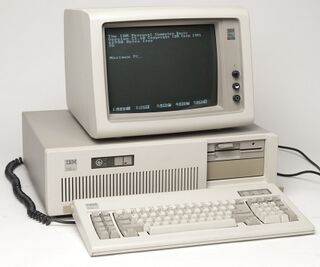|
|
| Line 1: |
Line 1: |
| − | [[File:Congobongocga.png|thumb|right|320px|''[[Congo Bongo]]'' was ported to the original DOS-based IBM PC in 1984. Despite only having four colours to choose from, it was seen as one of the more accurate arcade ports of the time.]] | + | [[File:IBMPCAT.jpg|right|320px]] |
| − | The original DOS-based IBM PC was released in 1981, and the technology behind it has been extended every year for nearly three decades to produce the Microsoft Windows machines of today. [[Sega]] released games for the DOS market in two waves, the first during the early 1980s where Sega published all releases themselves, and the second during the late 1980s and early 1990s where the publishing rights were held in the hands of companies such as [[Activision]] and [[U.S. Gold]].
| + | {{CategoryIntro|IBM PC}} |
| − | | |
| − | DOS-based computers were very popular for businesses during the 1980s due to higher resolution displays and more readily available word processing packages. They were originally far too expensive for use in the home, but as hardware prices dropped it was able to become a more competitive platform. Eventually the technology behind the IBM PC range would be adopted by other manufacturers, thus creating "IBM PC compatibles" that would fuel the success of the Microsoft Windows operating system.
| |
| − | | |
| − | Early Sega games were distributed as "PC Booter" games, which ran straight off a floppy disk as storage space was still very expensive. As the original IBM PC's graphics capabilities were not great, most games had to rely on the four colour CGA graphics cards of the era and would have to make use of the bulit in PC speaker (which still exists in computers today). Later games would use the EGA and VGA standards which would provide more colours, and would make use of Adlib and Soundblaster sound cards for higher quality sound.
| |
| − | | |
| − | DOS game production by Sega, like other computers of the time, was cancelled during the early 1990s as there was more money to be made on the successful [[Sega Mega Drive]] console. Sega would revisit the computer market when Microsoft Windows became popular, however.
| |
| − | | |
| − | Though in theory all DOS games should still run on modern computers (as Windows itself was DOS-based for the first few years), running these games, especially the earlier ones, may produce bad results. As early games such as ''[[Zaxxon]]'' do not have a hard-coded speed limit, chances are it will run far too fast on computers of today, which is why it is better to use an emulator such as DOSBox.
| |
| | [[Category:Home computers]] | | [[Category:Home computers]] |
The IBM PC is a range of computers released by IBM over the course of the 1980s. Aimed primarily at business users, the original IBM PC 5150 was an expensive but robust machine designed for text input, however its use of off-the-shelf parts and modular design allowed the system to be tailored to a wide variety of needs, including video games.
The IBM PC is one of the most significant computers ever released, as while the design was easily replicated (to the point where IBM had stopped being the biggest supplier of so-called IBM PC compatibles by the mid-1980s), its successes in the business (and later home markets) coupled with the Microsoft operating systems MS-DOS and later Windows, mean it is the ancestor of the vast majority of computers in use today.
For information, see IBM PC.
